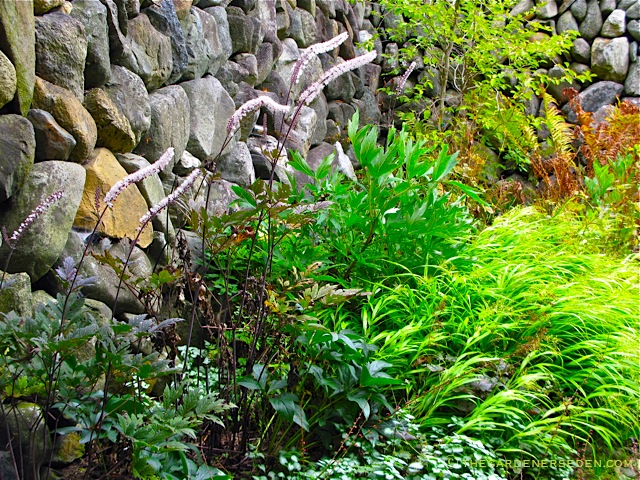Fashionably Late & Dressed in Maroon: Sweetly-Scented, Autumn Fairy Candles Light Up the Shadowy, Secret Garden…
 Actaea simplex/Cimicifuga simplex ‘Hillside Black Beauty {also known variously as Fairy Candles, Black Snake Root & Black Cohosh}
Actaea simplex/Cimicifuga simplex ‘Hillside Black Beauty {also known variously as Fairy Candles, Black Snake Root & Black Cohosh}
 Actaea simlex ‘Hillside Black Beauty’, here in the Secret Garden with Hakonechloa macra ‘All Gold’, Lamium maculatum, Helleborus x hybridus ‘Royal Heritage Strain’, Paeonia mouton x lutea ‘High Noon’, Stewartia pseudocamilla, and a background of bronzing Matteuccia pensylvanica {native Ostrich fern}
Actaea simlex ‘Hillside Black Beauty’, here in the Secret Garden with Hakonechloa macra ‘All Gold’, Lamium maculatum, Helleborus x hybridus ‘Royal Heritage Strain’, Paeonia mouton x lutea ‘High Noon’, Stewartia pseudocamilla, and a background of bronzing Matteuccia pensylvanica {native Ostrich fern}
True, there are those who say it’s rude to be tardy, but it seems to me that the more interesting characters always arrive a wee-bit late to the party. Of course, they are always gorgeous, a bit mysterious, and often wearing something dark and dramatic. Well, such is the case with Actaea simplex {aka Cimicifuga simplex} ‘Hillside Black Beauty’, in my Secret Garden. Clad in exquisitely-cut, deep, velvet-maroon, the Fairy Candles —as I like to call them— saunter into bloom in September; wearing their lilac-tinted, flower plumes the way an old-fashioned bombshell might drape her shoulders with an exotic, perfumed boa. Filling the cool, misty air of the Secret Garden with the most delightfully intoxicating scent, {noticed and adored by hungry bees and other early autumn pollinators} Actaea simplex arrives late on the garden-scene with the kind of laid-back elegance of which modern Hollywood starlets can only dream…
 Actaea simplex ‘Hillside Black Beauty’ in the Secret Garden {see companion plant listing above}
Actaea simplex ‘Hillside Black Beauty’ in the Secret Garden {see companion plant listing above}
Known by various intriguing aliases —including Black Snake Root, Black Cohosh and (my favorite) Fairy Candles— Actaea simplex was formerly categorized in taxonomic circles as Cimicifuga simplex (sim-e- sih-few-gah sim-plex); a delightful tongue-twister that, once mastered, I actually came to adore (In fact, I still refer to her by the original botanical name – the Latin just seems to capture her… Je ne sais quoi). Native to the moist, cool woodlands of eastern North America, this statuesque beauty will easily reach 4-6′ tall — spikes in full bloom— when she’s given the conditions she prefers. Hardy in USDA zones 4-8, Actaea simplex ‘Hillside Black Beauty’, and the similarly beautiful ‘Brunette’, require a consistently moist and amply shaded location to really strut their stuff. Too much sun will bleach and burn-out her gorgeous foliage , and dry soil will quickly do her in.
 It’s a shame the fragrance of Actaea simplex’s blossoms can not be transmitted electronically. I wish you could sample the delicious scent…
It’s a shame the fragrance of Actaea simplex’s blossoms can not be transmitted electronically. I wish you could sample the delicious scent…
A classy beauty like this demands fine company. And with her year-round, velvety, maroon attire, chartreuse and gold foliage make gorgeous music with her in the low-light. I like to combine the dark foliage of  A. simplex ‘Hillside Black Beauty’ and ‘Brunette’ with low, spreading, golden Japanese Forest Grass (Hakonechloa macra ‘All Gold’ or ‘Aureola’), mound-shaped Hosta ‘August Moon’, and for serious drama, I play her against my favorite chartreuse -stunner, Sambucus racemosa ‘Sutherland Gold’ (European elder). Yes, Actaea simplex ‘Hillside Black Beauty’ is a true garden bombshell – but of the dark variety, not the blonde— like Hedy Lamarr. She’s sultry, she’s elegant, and she really knows how to bring down the house in style….
 Inspiration: Hedy Lamarr {image: still from ‘The Strange Woman’ United Artists 1946 (public domain)– via improbable research}
Inspiration: Hedy Lamarr {image: still from ‘The Strange Woman’ United Artists 1946 (public domain)– via improbable research}
 Hedy Lamarr {Alfred Eisenstaedt, 1938 – image via zimbio.com}
Hedy Lamarr {Alfred Eisenstaedt, 1938 – image via zimbio.com}
 Hedy Lamarr {image via zimbio.com}
Hedy Lamarr {image via zimbio.com}
***
Article and photos (excepting portraits of Hedy Lamarr) are â“’ Michaela at TGE
All content on this site, (with noted exceptions), is the property of The Gardener’s Eden and may not be used or reproduced without prior written consent. Inspired by something you see here? Great! Please give credit where credit is due. It’s a small world and link-love makes for fond friendships. Stealing makes for bad dreams…
Do you enjoy visiting The Gardener’s Eden? You can help support this site by shopping through our affiliate links. A small percentage of any sale originating from The Gardener’s Eden site will go toward web hosting and maintenance costs. Thank you for your support!
***
6 Replies to “Fashionably Late & Dressed in Maroon: Sweetly-Scented, Autumn Fairy Candles Light Up the Shadowy, Secret Garden…”
Comments are closed.


Hi Michaela,
I have noticed in postings before, and today, that you have the Paeonia mouton x Lutea ‘High Noon’ planted in a shade garden. I always thought that peonies of any kind needed full sun. Does this one not need full sun? Does it still bloom even though it is in the shade?
Thank you very much. I look forward to your posts.
Dinnie
Hi Dinnie,
Good question. I have two ‘High Noon’ tree peonies in a partially shaded section of my Secret Garden, and they perform beautifully. Both plants bloom profusely (I think I posted photos in the spring, but can’t remember at the moment), and both have reached approximately 3 1/2 feet in height. They are very healthy, with lush foliage and a healthy framework. Although the vast majority of the Secret Garden is planted beneath a steel balcony, part of it is not. The far corner, where the Stewartia pseudocamilla is planted, receives partial sun (in the morning), and is brightly lit with indirect light throughout the day. The tree peonies are positioned right at the edge of the steel balcony’s shadow and receive 1/2 day of morning sun (approximately 6 hours in summer). In my experience, tree peonies seem to prefer to be shaded from the hot afternoon sun, and will perform very well with a half day of sun (preferably in the morning) so long as they are positioned in a generally bright spot. It’s far more important that the other cultural requirements be met: ample moisture, good drainage and hummus-rich soil. However, I have found that herbaceous peonies are far less tolerant of shady sites. I always plant herbaceous peonies in full sun.
It’s nice to hear from you. Thank you for following the blog!
Michaela
Here is a link to a photo I posted this spring. This will give you an idea of how lovely the ‘High Noon’ tree peony is, in full bloom. It is a gorgeous, huge flower with a wonderful fragrance. Both plants bloom profusely… In fact, I often cut blossoms to float in water bowls, inside the house…
https://www.thegardenerseden.com/wp-content/uploads/2010/05/Paeonia-High-Noon1.jpg
Thank you!! I’ll start scouting the yard for a good space for it.